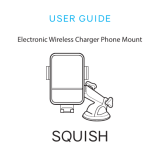
TABLE OF CONTENTS
INDEX
VISUAL INDEX
VOICE COMMAND
INDEX
SAFETY
INFORMATION
CUSTOMER
INFORMATION
INSTRUMENT PANEL
SPECIFICATIONS
VEHICLE
CONTROLS
MAINTENANCE
AUDIO AND
CONNECTIVITY
HANDLING THE
UNEXPECTED
BLUETOOTH®
HANDSFREELINK®
DRIVING
HONDALINK®
NAVIGATION
INTRODUCTION
This Owner’s Guide is intended to help you quickly get acquainted with your
2018 Honda Civic Hatchback. It provides basic information and instructions on
technology and convenience features, as well as emergency procedures and how to
get assistance.
This guide is for vehicles sold in the United States and Canada. It covers all Civic
Hatchback models, so you may find descriptions of features and equipment that are
not in your vehicle. Images throughout this guide are from U.S. vehicles and represent
features and equipment that are available on some, but not all, models.
This guide is not intended to be a substitute for the Owner’s Manual and Navigation
Manual at owners.honda.com (U.S.) or myhonda.ca (Canada). The Warranty
Information CD enclosed in your glove box kit includes the vehicle and tire warranties
in electronic format. This information can be viewed on a computer (PC or Mac
platform) and saved or printed for your reference. You can also visit to view the
complete and most current information.
If you are the first registered owner of your vehicle, you may request a complimentary
printed copy of the Owner’s Manual, Navigation Manual, or Vehicle Warranty within
the first six months of vehicle purchase. To request a copy, visit owners.honda.com
(U.S.) and create or log in to your account. In Canada, please request a copy from
your Honda dealer.
American Honda Motor Co, Inc. strives to be proactive in protecting our environment
and natural resources. By using electronic delivery for a considerable portion of the
information typically found in a vehicle owner’s manual, we are further reducing our
impact on the environment.
Honda Automobile Customer Service
Your authorized Honda dealer should be able to answer any questions you have
about your vehicle. However, if you are dissatisfied with the information you receive,
you can call Honda Automobile Customer Service (see page 153).
Call (800) 999-1009 (U.S.) or (888) 946-6329 (Canada)
Honda Roadside Assistance
24-hour emergency road service is available to you in the United States and Canada
throughout your 3-year/36,000-mile warranty term. Services include jump starting,
flat tire and lockout assistance, towing, and more (limitations apply).
Call (866) 864-5211 (U.S.) or (800) 465-7587 (Canada)
TABLE OF CONTENTS
*if equipped
VISUAL INDEX .............................................................. 1
Steering Wheel and Nearby Controls ...............1
Dashboard, Ceiling, and Other Controls ...........2
SAFETY INFORMATION .............................................. 3
Important Safety Information .............................3
Seat Belts...............................................................5
Airbags ...................................................................8
Child Safety .........................................................14
Safety Label Locations ......................................21
Reporting Safety Defects ..................................22
INSTRUMENT PANEL ................................................ 23
Malfunction Indicators ......................................24
Condition Indicators ........................................... 26
On/Off Indicators ................................................27
Information Display* ..........................................28
Driver Information Interface* ........................... 29
VEHICLE CONTROLS .................................................. 31
Using the Key or Remote Transmitter* ...........31
Smart Entry System* .......................................... 32
Door Operation ...................................................35
Power Window Operation ................................36
Power Moonroof Operation* ........................... 37
One-Touch Turn Signal ......................................37
Interior and Exterior Lights ...............................38
Auto High-Beam System* .................................39
Wiper Operation .................................................41
Adjusting the Seats ............................................43
Cargo Cover ......................................................... 46
Adjusting the Steering Wheel ..........................47
Adjusting the Mirrors ......................................... 47
Climate Control System ....................................48
Seat Heaters* .....................................................51
Customized Features* .......................................52
Setting the Clock ................................................53
AUDIO AND CONNECTIVITY .................................... 54
Basic Audio Operation ......................................54
Models with Color Audio System ....................59
Color Audio System .........................................59
FM/AM Radio .................................................... 60
iPod
®
................................................................61
USB Flash Drive ...............................................62
Bluetooth
®
Audio .............................................63
Models with Display Audio ...............................64
Display Audio Operation .................................64
HondaLink
®
......................................................65
Wi-Fi Connection .............................................66
Apple CarPlay
™
................................................ 67
Android Auto
™
..................................................68
FM/AM Radio ................................................... 69
SiriusXM
®
Radio* ............................................. 70
iPod
®
.................................................................71
USB Flash Drive ...............................................72
Bluetooth
®
Audio .............................................73
Pandora
®
* .........................................................74
BLUETOOTH HANDSFREELINK
®
(HFL) ................... 75
Models with color audio system ...................... 75
Basic HFL Operation ........................................ 75
Pairing a Phone ................................................76
Making a Call ....................................................77
Models with Display Audio ...............................78
Basic HFL Operation ........................................ 78
Pairing a Phone ................................................80
Making a Call ....................................................81
HondaLink
®
Assist ...........................................82
SMS Text Messaging and E-Mail* ................ 83
Siri
®
Eyes Free ..................................................84
NAVIGATION* ............................................................. 85
Basic Navigation Operation .............................85
Entering a Destination .......................................87
Routing .................................................................90























